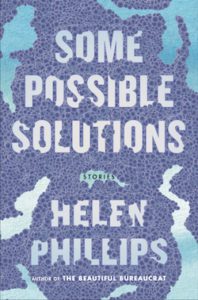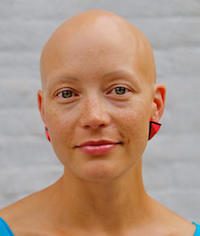
To pose a solution is to identify a problem. This holds true in Helen Phillips’s most recent and immensely engaging collection, Some Possible Solutions, which, despite its title, presents a host of difficult challenges: the disastrous effects of climate change, technological malfunction, sexual dysfunction, and a mother’s inability to connect with her child. Such problems are relatable because real-life people experience them every day, but the worlds in which they wreak havoc are strange and unfamiliar, even terrifying—a juxtaposition that makes for an uncanny but captivating read.
Consider the collection’s opening story “The Knowers,” which takes place in a society where everyone has the option of learning the date of their death. Though such a place exists only in fiction, the pain the “knowers” unintentionally inflict on loved ones before working with them to overcome their agony, all feels heartbreakingly real. In the “Contamination Generation,” Phillips conjures a frightening alternate universe—or perhaps a possible near-future—wherein the Earth has suffered catastrophic environmental damage. Such a world doesn’t exist (yet), but the jealousy exhibited by poor families as they gaze upon their wealthy neighbors’ vast estates brims with verisimilitude.
Phillips is not new to emotionally powerful speculative fiction. She is an award-winning author of four books, including the 2015 novel The Beautiful Bureaucrat, which tells the story of a young couple—Josephine and Joseph—trying to start careers and a family. Their life together begins with promise: they find jobs and an apartment fairly quickly. But it soon becomes clear that there’s something not right about Josephine’s workplace. The building she works in is shadowy and windowless, and her boss’s face always looks out of focus no matter how hard she stares. She soon realizes that she hadn’t been told exactly who she’s working for. As she tries to solve that mystery, strange happenings begin to affect her life at work and home.
When first published, the novel earned Phillips comparisons to Kafka. It’s a fitting comparison in terms of talent and tone (her work is both darkly existential and funny). But Phillips’s writing as a whole includes more woman-centered narratives. In this collection, Phillips delves into the frustrated psyches of new mothers who recognize little of themselves in their children. The mother of a newborn in “The Doppelgangers” suffers the joys and disappointments that come with her new role—she delights at her baby’s smiles but finds it difficult to reconcile her identity as mother with her former self. Her struggle soon takes on a deeper and stranger meaning as the faces of other new mothers become a bit too familiar. Everywhere, from the grocery store to the local café, she sees women who look identical to herself tending to families that appear the same as her own. It’s as if motherhood has rearranged not only her sense of self, but the physical world as she knows it. The mother in “Children” questions reality by insisting to her husband that their offspring might not be of this world. I’ll avoid spoiling whether her suspicions are correct, but I will say this: the story did not end the way I expected. Elsewhere in this collection, Phillips takes up the subject of menstruation, but instead of employing the usual trope of equating menstrual blood with supernatural powers, she allows it to signify something far more important and universal—hope for the future.
Phillips complicates her focus on womanhood through a fascinating treatment of gender. In “The Beekeeper” a percentage of the population has evolved beyond the need for specific gender identities. Their sexual orientations are equally ambiguous, which confuses their cisgender peers as to whether they have any sex drive at all. This confusion, while not quite the point of the story, lays the foundation for a beautiful narrative about the need for personal connection. These themes of connection and gender fluidity are heightened in “The Joined,” which posits that every human being on Earth has a male or female counterpart living on a newly-discovered planet. When beings from both worlds meet, they snap together in a flash of black to form a complete self, not quite man or woman, but both. The possibility of becoming one half of a whole presents a difficult choice for humans already matched up with other humans: do they part ways to spiritually and biologically join with their alien soulmates, or stay together and always wonder what might have been?
An abused Earth frequently serves as a backdrop for these stories. It’s an Earth populated by children raised on monstrous GMOs, where wind is unheard of, where it’s become suburban de rigueur to withhold complaints about the trash heaps blocking the front door. Phillips limits
exposition, so there’s little explanation for how the planet became so polluted. The stories therefore fall short of ecocriticism, but that hardly matters. In the best speculative fiction, world’s aren’t analyzed, they just are.
Some Possible Solutions is a dark read filled with people in pain and lives upended by the most unpredictable of circumstances. But it’s also tremendously hopeful. At times hope arrives in the form of new technology; elsewhere it’s transmitted through the tenderness of other human beings. Perhaps, then, the key word in the book’s title is not “solutions”, but “possible”—because within these pages, anything is.





